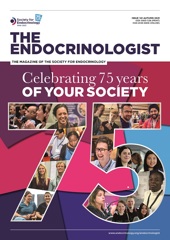In looking forward to what the future might bring, it’s always terrific fun to look backwards first. In the last issue, The Endocrinologist reprinted an article from 2000 by Professor John R G Challis (Toronto, Canada), in which he envisioned where we would be by 2020.
He said, ‘New genetic techniques, arising in association with the completion of the Human Genome Project, will offer extraordinary new opportunities for partnerships between pharmaceutical companies and academia, in the pursuit of discovery-driven, rather than hypothesis-driven, science. Recognition of epigenetic effects and the role of lifestyle in health performance seem likely to emerge as trends that will influence the spectrum from basic science research to public health policy.’
Continuing, he added, ‘In a post-genome world, we may envisage complete genotyping of all individuals, a genome-based pharmacology, animal models for every gene, near real-time measurements of gene transcription, and the microdissection of individual cellular processes.’
I think he did rather well, and I don’t expect to be as prescient. It would be professional madness – with uncomfortable annual reminders at each SfE BES conference, as my ill-considered predictions became less and less likely – to try and guess specifically what lies 20 years ahead. For what was brave in 2000 is now foolish in 2021. But maybe this is a game we endocrinologists should play every decade or two: where are we now and where are we heading?
It would be professional madness...to try and guess specifically what lies 20 years ahead. For what was brave in 2000 is now foolish in 2021.
A MAP WITH NO ROADS
Progress in human biology is quickening at an unprecedented rate, with no sign of it slowing down. On the horizon are entirely new ways of understanding and augmenting health. Things are not moving along incrementally. Rather, we feel as if on the perpetual brink of a revolution. But the direction of travel is a map with lots of potential arrival points and no plotted routes. Who knows where we will end up? The future is never linear; it is sideways and lurching and branching and bewildering but, of course, always looks inevitable when looked back upon.
However, it is easy to examine the research technologies we currently have and to note their limitations and compromises. CRISPR is cumbersome and doesn’t always get you where you want to go. Mouse models remain slow and expensive. Successful drug design appears inevitable until you test the drugs, and watch as computationally derived compounds become less and less useful as you progress from cells to mice to humans. Cell models themselves are pale and malignant imitations of real life. Easy genomics remain hamstrung by difficult bioinformatics. Modelling the multiple gene interactions which underlie complex diseases such as obesity remains virtually impossible. The future will need to solve these persistent issues in order to allow us to lurch forwards.
BUREAUCRACY VS PROGRESS
One current barrier to progress lies elsewhere, in the increasingly difficult regulatory approvals environment. Progress may be partly about finding new ways of addressing regulatory control and killing unnecessary bureaucracy, whilst still protecting the high moral standards that we all aspire to.
For instance, the protectionist stance of UK universities in material transfers, animal ethics and COSHH assessments (all worthy but dull) could be expedited and made more efficient. We may look back and wonder exactly why we bound our researchers so tightly in red tape, which slowly strangled creativity, competitiveness and progress, while there were urgent endocrine problems to solve.
Most of us carry out our research within the strictures of the university system. The academic career has become a terrible choice of career, however. Metricised to death, enumerated into early defeat, beholden to the short term whims of grant funders and slowly destroyed by the good intentions of senior management, it is death by a thousand new initiatives, all of which seem to destroy momentum.
We look enviously at those colleagues who work in dedicated research centres, and who somehow manage to carry out their work unencumbered by undergraduate teaching, postgraduate supervision, clawing administration, permanent grant writing, endless form filling, exam setting, student tutoring, and damned Research Excellence Framework impact cases. Some of these scientists may even have parking spaces.
If we were to invent de novo structures in which medical research could flourish, they would look almost polarically different to 21st century universities. However, one thing that they do foster is an altruistic interface between clinicians and basic scientists.
If we were to invent de novo structures in which medical research could flourish, they would look almost polarically different to 21st century universities. However, one thing that they do foster is an altruistic interface between clinicians and basic scientists. Crossing disciplines remains paramount for future progress. We need new ways of scientific interaction that spark game-changing interdisciplinary advancement. In this regard, endocrinology is already primed, being the very broadest of broad churches, and interdigitating with multiple other branches of science and medicine, including drug design, chemistry, biomaterials research, advanced surgery and radionuclide imaging, etc. Professor Challis envisioned direct partnerships between pharmaceutical companies and academia, and this remains a model which might still bear fruit.
FAITH, FUNDING AND AN IDENTITY CRISIS
Future progress also clearly depends on current research funding. Which, in turn, depends on how the Government and public feel about the importance of research versus (for example) nuclear submarines or albino pachyderm railways. A lot was hanging therefore on the ability of scientists to rescue us from COVID. The public’s faith in science has been enhanced by the demonstrable progress that epidemiologists, virologists and vaccine specialists have made in tackling the pandemic. Even endocrinologists are getting in on the act. Will this mean enhanced funding opportunities for us? I’m not sure it will.
Endocrinology as a fundable discipline is in deep identity crisis. In three years of chairing the Wellcome Trust Basic Science Interview Committee, and a further three years as a panel member, I think that maybe three or four of the approximately 1,000 Sir Henry Wellcome Fellowships that I read dared to throw the word ‘endocrinology’ in. I’m not sure any were funded.
Of course, in more clinical schemes, where there lies a direct line of sight from the patient to the research question, the stats will be more favourable. They could hardly be less so. But we have to face the fact that funding favours the endocrinologists who masquerade as cell biologists, developmental biologists, neuroscientists, cardiovascular physiologists, metabolism workers and cell signallers. Unfortunately, semantics like this matter when a learned society such as ours seeks to protect its future identity, to support its members and to advocate for research support. This remains a difficult challenge for the Society for Endocrinology.
But there is room for optimism. In my own field of endocrine cancer, progress measurable in additional months of life – maybe the noblest of all currencies – is being made. New strategies for the treatment of diabetes and obesity are constantly being appraised. Our ability to understand complex endocrine disorders is accelerating. Progress will inevitably depend on now evolving the correct structures, finances and environments in which to allow ideas to become treatments.
So, if I had to look 20 years ahead, I think the future is simple: enhanced technologies furnishing novel mechanistic insights into human disease which inform new strategies for drug design to provide the raw material for enhanced treatment. I look forward to being proved wrong in two decades’ time.
CHRIS McCABE
University of Birmingham






